How Does Coyote Urine Repel Raccoons Effectively?
Coyote urine has been shown to effectively repel raccoons, leveraging predator-prey dynamics to induce avoidance behaviors. Studies indicate that raccoons show measurable aversion to areas treated with coyote urine, resulting in decreased activity.
The repellent effect is contingent on weather conditions, requiring periodic reapplication, particularly after rainfall. Field trials support its efficacy as part of integrated pest management strategies.
However, factors such as habituation and resource availability can influence the degree of deterrence. For a more thorough understanding of how coyote urine serves as a deterrent and its application strategies, further details are available.
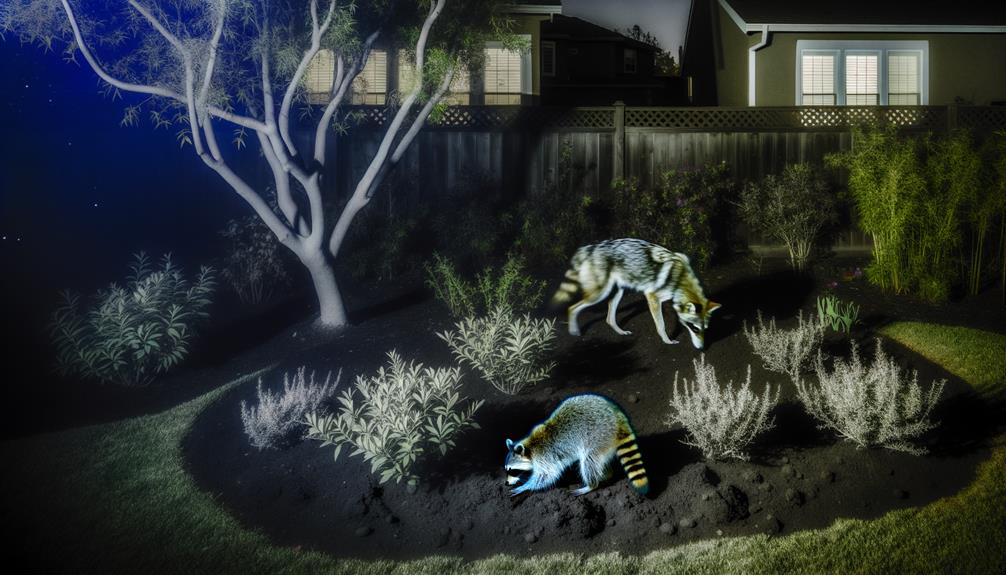
Key Takeaways
- Coyote urine triggers avoidance behaviors in raccoons due to compounds signaling predator presence.
- Field trials and laboratory tests confirm the efficacy of coyote urine in repelling raccoons.
- Motion-activated cameras document decreased raccoon activity in areas treated with coyote urine.
- Regular reapplication of coyote urine is necessary for sustained deterrence due to environmental degradation.
- Coyote urine is a practical tool in integrated pest management strategies for raccoon control.
Understanding Raccoon Behavior

Raccoons are nocturnal mammals known for their adaptability and opportunistic feeding habits, which allow them to thrive in diverse environments ranging from rural to urban areas.
Scientifically classified as Procyon lotor, raccoons exhibit both arboreal and terrestrial behaviors, utilizing their dexterous front paws to forage for a wide variety of food sources.
Research indicates that raccoons have a highly developed sense of touch, which aids in their ability to locate and manipulate food items, including insects, fruits, and small vertebrates.
Their cognitive abilities are notable, as they demonstrate problem-solving skills and memory retention.
Moreover, raccoons' social structures are typically solitary, though they may form communal dens during colder months.
Understanding these behaviors is critical for developing effective management strategies.
The Role of Coyote Urine
Coyote urine, a natural byproduct of predator activity, is often employed as a deterrent in wildlife management due to its potential to exploit the innate fear responses of prey species such as raccoons. This application leverages the chemical signals present in the urine, which raccoons may interpret as indicators of predator presence.
The effectiveness of coyote urine as a repellent can be attributed to several factors:
- Chemical Composition: Contains specific compounds that signal predator presence.
- Behavioral Impact: Triggers avoidance behaviors in raccoons.
- Environmental Persistence: Can remain effective for varying durations depending on weather conditions.
- Application Methods: Can be applied in various forms such as liquid, granules, or soaked rags.
Using these characteristics, coyote urine serves as a practical tool in managing raccoon populations.
Predator-Prey Dynamics
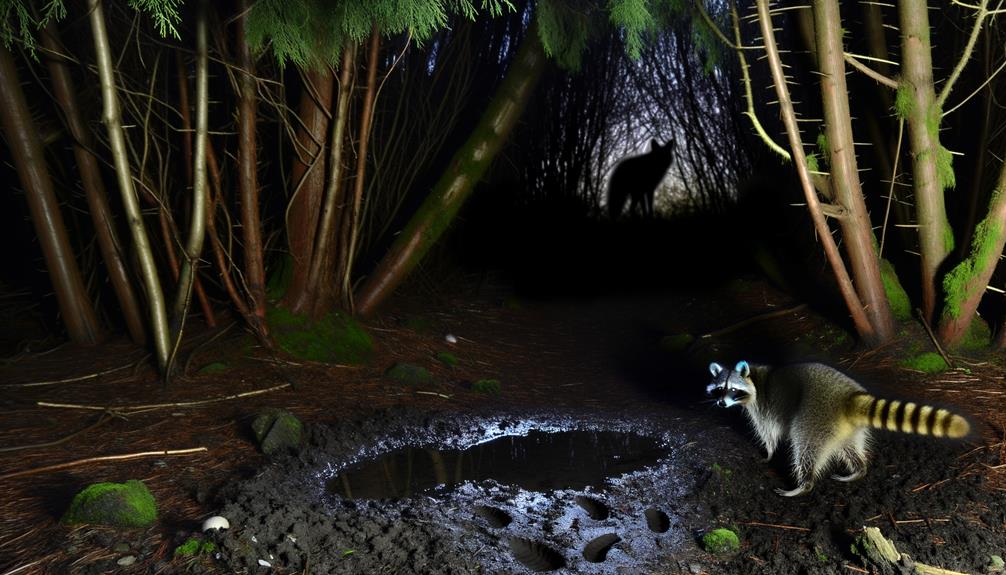
In the context of predator-prey dynamics, the interactions between species such as raccoons and their natural predators can greatly influence behavioral patterns and habitat utilization.
Raccoons, as mesopredators, often alter their activities and distribution in response to the presence of apex predators like coyotes. The fear of predation can lead to significant changes in raccoon foraging behavior, movement patterns, and spatial distribution.
This phenomenon, known as the 'landscape of fear,' can cause raccoons to avoid areas heavily marked by coyote scent. Consequently, the presence of predator cues such as coyote urine may act as a deterrent, reducing raccoon activity in specific locations.
Understanding these dynamics is vital for developing effective wildlife management and conservation strategies.
Scientific Studies
Scientific studies have provided essential insights into the effectiveness of coyote urine as a raccoon repellent. Experimental research findings indicate variable outcomes, with some studies showing reduced raccoon activity in areas treated with coyote urine.
Behavioral response analysis further elucidates the mechanisms by which raccoons perceive and react to predator cues in their environment.
Experimental Research Findings
Recent empirical studies have systematically evaluated the efficacy of coyote urine as a deterrent for raccoons, providing a strong dataset for analysis.
Various controlled experiments have been conducted to ascertain the validity of this method. Importantly, these studies have focused on several key parameters:
- Field Trials: Observational studies conducted in natural habitats to monitor raccoon activity in the presence of coyote urine.
- Laboratory Tests: Controlled environments where variables such as scent concentration and exposure time were carefully regulated.
- Behavioral Metrics: Quantitative measures including frequency of raccoon visits and changes in foraging behavior.
- Comparative Analysis: Evaluation against other deterrents such as predator sounds and physical barriers to determine relative effectiveness.
These findings offer a thorough understanding of coyote urine's role in raccoon management.
Behavioral Response Analysis
Behavioral response analysis in scientific studies has revealed nuanced insights into how raccoons react to the presence of coyote urine. Research indicates that raccoons exhibit a measurable degree of aversion when exposed to coyote urine, a known predator cue.
Controlled experiments utilizing motion-activated cameras and scent-marked zones have documented significant decreases in raccoon activity in treated areas compared to controls. However, the degree of aversion varies, suggesting that factors such as habituation, resource availability, and environmental context play critical roles.
While initial avoidance is evident, prolonged exposure may reduce the efficacy of coyote urine as a deterrent. These findings underscore the complexity of predator-prey interactions and suggest that coyote urine could be part of an integrated pest management strategy.
Anecdotal Evidence
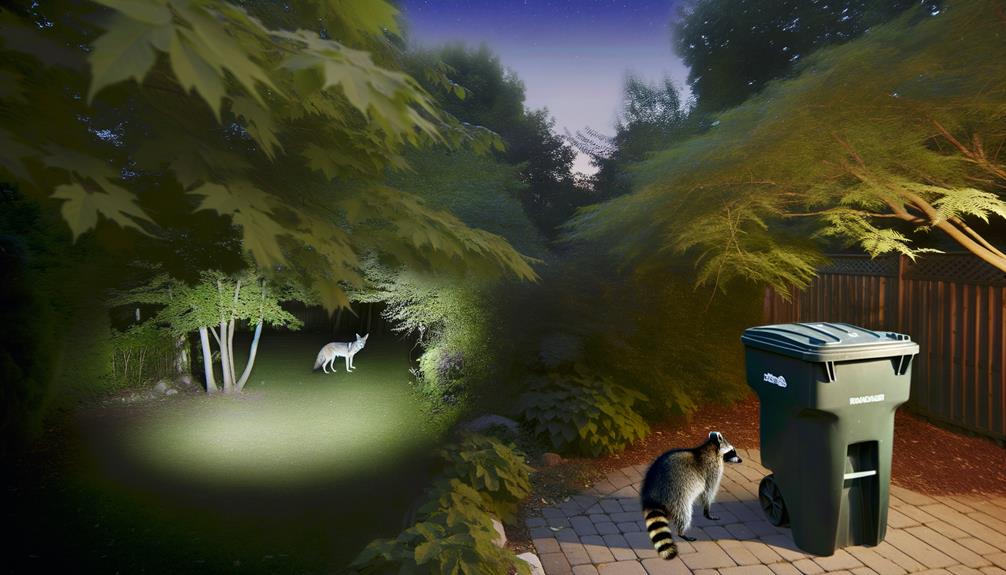
Numerous personal accounts suggest that coyote urine may be effective in deterring raccoons. These anecdotal reports provide some insight into its potential efficacy.
Observations from individuals include:
- Homeowners: Many have reported fewer raccoon intrusions in gardens and trash areas after applying coyote urine.
- Farmers: Several testimonials indicate a significant reduction in raccoon-related crop damage.
- Wildlife rehabilitators: Some professionals note behavioral changes in raccoons when exposed to coyote urine, suggesting a natural aversion.
- Pet owners: Instances of raccoons avoiding pet feeding areas treated with coyote urine are frequently mentioned.
While these anecdotal experiences are compelling, they do not constitute rigorous scientific evidence. Further empirical research is required to validate these observations and to understand the underlying mechanisms.
Application Methods
The efficacy of coyote urine as a raccoon deterrent can be influenced by various application methods. These methods include spray distribution techniques, the strategic placement of urine-soaked rags, and perimeter application strategies.
Each approach offers different advantages and limitations, which will be analyzed based on existing empirical data.
Spray Distribution Techniques
Effective spray distribution techniques are vital for maximizing the efficacy of coyote urine as a raccoon repellent. Scientific studies have demonstrated that the strategic application of the repellent increases its effectiveness.
Key techniques include:
- Uniform Coverage: Ensuring even and thorough coverage of the target area helps maintain a consistent scent barrier.
- Optimal Concentration: Using the recommended levels of concentration ensures the urine's chemical signals are strong enough to deter raccoons.
- Repeated Applications: Regular reapplication, especially after rainfall, maintains the scent's potency over time.
- Targeted Areas: Focusing on high-traffic zones, such as garden perimeters and entry points, maximizes deterrent effects.
These methods, grounded in evidence-based practices, are essential for those seeking reliable and sustained raccoon repellent results.
Soaked Rag Placement
Applying coyote urine-soaked rags strategically around the property can create a potent olfactory barrier deterring raccoons effectively. To maximize efficacy, rags should be saturated with coyote urine and placed in areas frequented by raccoons, such as near garbage bins, garden beds, or entry points to attics.
Scientific evidence suggests that raccoons are highly sensitive to predator scents, resulting in behavioral avoidance when exposed to such stimuli. Regularly reapplying the urine to maintain its potency is essential, as volatilization can diminish its effectiveness over time.
Additionally, using multiple rags can enhance coverage, thereby reducing the likelihood of raccoons becoming habituated to the scent. This method, supported by empirical observations, offers a non-lethal strategy for managing raccoon intrusions.
Perimeter Application Strategy
Utilizing a perimeter application strategy involves systematically distributing coyote urine around the boundaries of a property to establish a continuous scent barrier that raccoons are likely to avoid. This method aims to mimic the presence of a predator, thereby deterring raccoons through olfactory cues.
Evidence suggests that regular reapplication enhances efficacy, given that environmental factors such as rain and wind can dilute the scent.
- Concentration: Ensuring the urine is concentrated to maximize the scent's longevity and detectability.
- Frequency: Reapplying the urine bi-weekly or after heavy rainfall to maintain an effective barrier.
- Coverage: Applying the urine at intervals of 10-15 feet along the perimeter.
- Safety: Utilizing gloves and protective gear to avoid direct contact with the urine.
Effectiveness Over Time
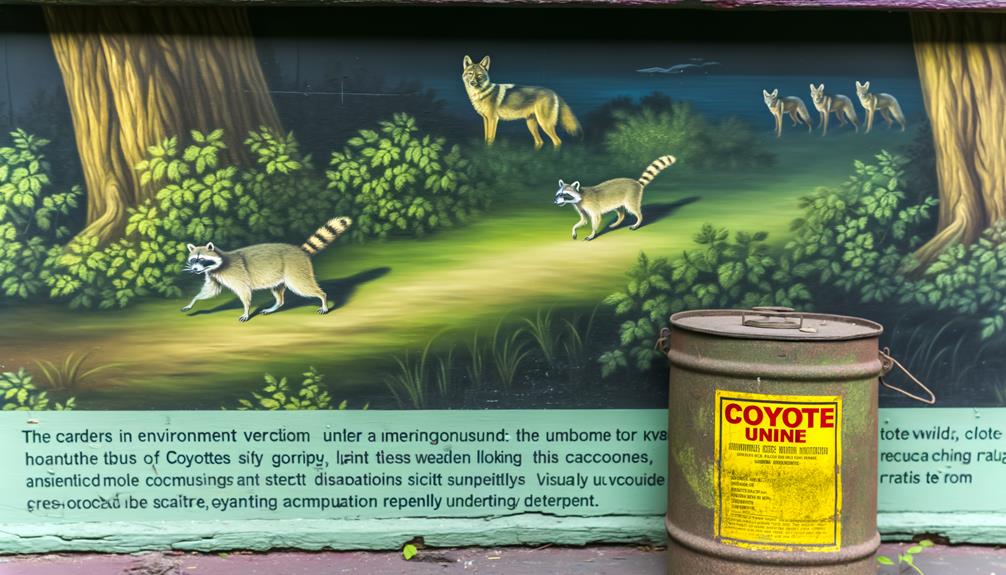
The longevity of coyote urine's repellent properties against raccoons hinges on various environmental factors, including precipitation, temperature fluctuations, and UV exposure.
Precipitation can dilute and wash away the urine, greatly diminishing its effectiveness. Elevated temperatures and UV rays accelerate the degradation of chemical compounds within the urine, reducing its potency.
Studies indicate that the repellent effect can diminish within a few days to weeks under adverse conditions. Reapplication is necessary to maintain its effectiveness, with intervals depending on the specific environmental conditions.
Empirical evidence suggests that, while initially effective, coyote urine's repellent properties require consistent upkeep for sustained raccoon deterrence. This temporal limitation underscores the need for an integrated pest management approach.
Alternative Repellents
Given the limitations of coyote urine in maintaining long-term effectiveness against raccoons, exploring alternative repellents becomes a practical approach to achieving sustained pest control. Research indicates that various repellents can offer enhanced efficacy and durability. For best results, these alternatives should be considered based on their scientific validation and application feasibility.
- Chemical Repellents: Substances like naphthalene and ammonia have shown efficacy in deterring raccoons.
- Electronic Repellents: Motion-activated devices emitting ultrasonic sound waves or bursts of water can be effective.
- Botanical Repellents: Essential oils such as peppermint and eucalyptus exhibit repellent properties.
- Physical Barriers: Installing mesh wire or electric fences can physically prevent raccoons from accessing certain areas.
Each of these methods offers unique advantages, and their application should be tailored to specific environmental contexts.
Safety Considerations
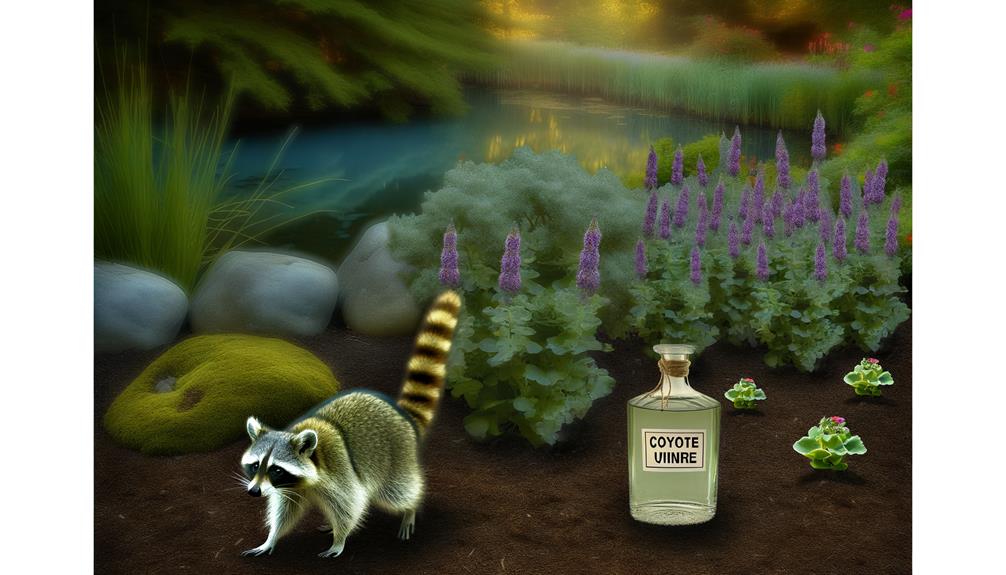
Ensuring the safety of humans, pets, and the environment is paramount when implementing raccoon repellents. Coyote urine, as a natural deterrent, warrants scrutiny regarding its potential health risks and ecological impact.
Studies indicate minimal risk to human health, as urine from healthy animals typically lacks harmful pathogens. However, caution is advised to prevent ingestion or contact with mucous membranes.
For pets, particularly dogs, exposure may induce anxiety or territorial behaviors. Environmental concerns include the potential for non-target species disruption.
Proper application procedures should be strictly adhered to, ensuring minimal ecological disturbance. Overall, while coyote urine presents a low-risk profile, thorough risk assessment and adherence to best practices are essential for safe and effective use.
Conclusion
To sum up, the use of coyote urine as a raccoon repellent presents a glimmer of hope amidst the shadows of uncertainty. While scientific studies and anecdotal evidence suggest some efficacy, predator-prey dynamics and application methods greatly influence outcomes.
Effectiveness may wane over time, necessitating the exploration of alternative repellents. Ensuring safety considerations are met is imperative for both humans and wildlife.
Further empirical research is essential to substantiate these findings and optimize strategies for raccoon management.





